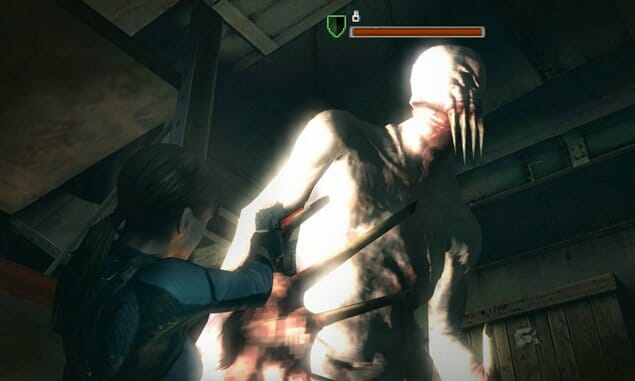Resident Evil: Revelations (3DS)

Capcom took a weird turn when marketing Resident Evil: Revelations.
“Classic survival horror returns!” they proclaimed, wheeling out trailers and a demo focused squarely on the atmosphere of the abandoned ocean liner setting of the latest installment. That was all well and good—Revelations’ demo had the same emulative feel of the original game’s Umbrella mansion that was put to such excellent use in Resident Evil 5’s Lost in Nightmares DLC—but following the fifth installment’s popcorn blockbuster approach, this push back towards horror was a bit of a surprise.
After playing the finished product I find this alleged promise somewhat disingenuous. Despite any enjoyment you may glean from it, Revelations is certainly not “classic survival horror”. It’s something of a mess, the constituent parts of its makeup all over the map. It’s almost as though halfway through the development cycle the team had a crisis of faith over what sort of game they were trying to make. At least, that’s how it plays.
I’ll give you an example: the game opens on the ghostly lower decks of the Queen Zenobia, Revelations’ most prominent location. In the shadowy, dank corridors of the bilge, the sound design is spare, with little characterizing your aural first impressions aside from the creaks and groans of the buoying ship and the occasional crack of thunder when near a porthole.
The Zenobia is, of course, crawling with a new breed of undead (note I didn’t say “not-zombies infected with parasites”) characterized by blobby barbed limbs and indistinct, clay-like features that hearken back to Resident Evil 4’s terrifying regenerator monsters. Minus the flashback in the game’s second chapter, dread pervades the dingy environments Jill Valentine and her new partner, Parker, are exploring; when you witness a woman’s traumatic end, forcibly splattered all over a window pane in the lower decks, the influence of Dead Space is almost painfully obvious.
For the moment it works, though the feeling never has a chance to sink in. Much of the Zenobia’s deck floors are set up once again to evoke the creepy nostalgia of the Umbrella mansion, yet after a quick jaunt through them it’s off to other parts of the ship, which more often than not take on a very different tone.

So the pacing is off at times. One minute you’re racing against a clock or blasting baddies with abandon. The next you’re engaging in obtuse puzzle solving or are engaged in some outside scenario entirely. In the later stages of scouring the Zenobia, you reach some flooded areas infested with skittering water roach monsters that can range from hard to hit to impossible to fight while completely submerged. There’s also a swimming section that’s similar to Raiden’s underwater rescue of E.E. in Metal Gear Solid 2, which seems oddly placed.
Compounding this is how often you jump between characters and locations from chapter to chapter. While this helps to break up some of the Zenobia’s more laborious sections (the episodic Revelations is in many ways an even more Hollywood-ized production than RE 5 was) it makes for a disjointed experience that’s undecided between horror and action.
Again, this feels like an obvious attempt to both give lip service to fans wanting a more traditional RE title—if such an ill-defined definition even exists anymore—and kowtow to industry pressure to keep current with trends that might make newcomers interested in the series. The resultant inconsistencies make it hard to identify with much of what the game presents.
A lot of this is an issue of writing. I would never presume to care about Resident Evil’s terrible scripts, given that atrocious dialogue and silly plots are as much a part of its charm as egregious violence or grotesque monster design. (In fact Barry’s “Jill Sandwich” line uttered in the the first game is probably among my all-time favorite lines of game dialogue.)
